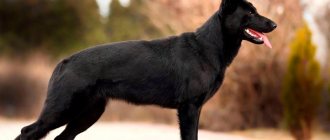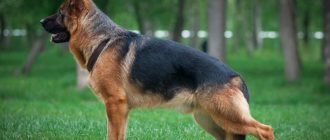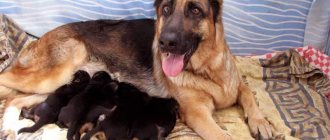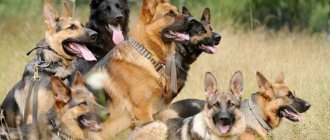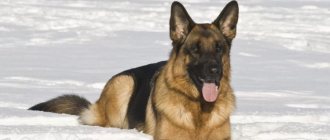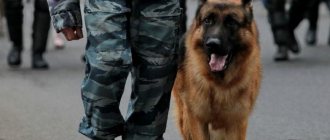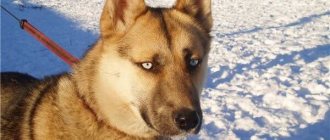German Shepherds are one of the smartest and most loyal dogs in the world, delighting their owners with energy and endless love of life throughout their lives.
However, before purchasing a puppy, you should find out about the health characteristics of representatives of this breed.
In particular, their hind legs often fail.
And in this situation, you need to know how to help your pet.
What problems can your pet encounter?
Chronic musculoskeletal problems
Chronic diseases of the musculoskeletal system include:
- dysplasia of the hip or elbow joint - most often a genetic pathology associated with abnormal development of the joint;
- knee dysplasia is a congenital joint disease in which malformations lead to damage to bone and cartilage and, as a consequence, osteoarthritis;
- panosteitis (pano) is a pathology called “wandering lameness” and is characteristic of puppies 5-12 months old.
It is also possible to develop arthrosis and arthritis.
Double punch
Blood clots, jelly-like clumps of cells and proteins, are the body's mechanism to stop bleeding. Blood clots form in blood vessels in response to damage to the inner wall. Some researchers view blood clotting as a key feature of COVID-19.
The effect of the virus on the immune system can also be manifested by increased blood clotting. In some people, COVID-19 triggers immune cells to release a flood of chemical signals that increase inflammation, which is associated with coagulation and blood clotting in a variety of ways. And the virus appears to activate the complement system, a defense mechanism that causes blood to clot and increases the risk of thrombosis in coronavirus.
Reasons for refusal
Impaired performance of the musculoskeletal system of German Shepherds can be caused by various diseases.
Dysplasia
A chronic pathology in which destruction of joints, ruptures of bone tissue and cartilage occurs.
If we are talking about an acquired disease, then it develops as a result of improper diet , obesity , deficiency or excess of vitamins and minerals, as well as due to serious physical activity in the puppy.
In cases where the disease is hereditary, animals have congenital abnormalities in the structure of the joints.
NOTE!
Symptoms appear only when the puppy reaches six months of age.
A sign of dysplasia is a hunchback instead of a smooth line.
Spinal diseases
As a result of bruises, as well as with discopathy, spondylosis, spondyloarthrosis and osteochondrosis, the fibrous rings are damaged, swelling and compression of the spinal cord and peripheral nerves are observed.
All this leads to the death of cells of the nervous system, which manifests itself in weakness of the limbs: from lameness to complete failure..
In some cases, spinal injuries can cause complete paralysis of the hind legs.
Oncology
Malignant or benign neoplasms on the brain or spinal cord, paws or spine can also cause malfunctions of the musculoskeletal system - tumors put pressure on the tissues and structure of the central nervous system.
There is a possibility of finding small swellings on the paws of older German Shepherds, and the dog may be limping and dragging its limbs.
If the tumors are localized in the spinal cord or brain, the German Shepherd experiences severe pain and paresis or complete paralysis of the limbs is noted.
Injuries
Injuries to the limbs, head, or spine sustained by a German Shepherd during play, fighting, walking, or an accident are another possible cause of hind leg failure.
In addition, any awkward movement, jump or fall of the dog can lead to a fracture, sprain, ruptured tendon or pinched nerve..
Expert opinion
Kozhevin Semyon Kirillovich
Expert dog handler.
German Shepherds are prone to developing diseases associated with the musculoskeletal system, therefore, first of all, they need a set of preventive measures to avoid limb failure. However, this can often be the result of a hereditary disease, when it is impossible to avoid the consequences. At the first signs of limb failure, you should immediately contact a veterinarian - only a specialist can carry out the necessary diagnostics and prescribe treatment. Remember - self-treatment will most likely be incorrect and can lead to death.
Low oxygen levels
COVID-19 has also been linked to blood clots in tiny blood vessels that are important for carrying oxygen in organs. Autopsy reports have found elements of SARS-CoV-2, the virus that causes COVID-19, in the cells lining these small blood vessels in the lungs, kidneys and intestines.
This can cause tiny blood clots to form in these small blood vessels, which interfere with normal blood flow and the blood's ability to deliver oxygen to these organs. It is important to note that these small blood clots can interfere with normal lung function. This may explain why patients with severe COVID-19 may have very low oxygen levels.
Symptoms of pathology
The fact that a German Shepherd's limbs are failing can be judged by the following symptoms::
- the dog squats on its paws, limps, while moving, the limbs remain straight and do not bend at the joints;
- the pet whines and squeals during movement due to severe pain;
- rapid breathing and convulsions are observed;
- swelling forms on the paws in the area of the joints;
- the animal prefers to lead a recumbent lifestyle or, on the contrary, behaves restlessly;
- in some cases, the German Shepherd cannot stand on its paws and drags them behind itself when moving;
- It is possible that aggression may occur when the owner or doctor tries to examine the hind legs or simply touch the back.
The earlier the pathology is diagnosed, the higher the chances of a positive outcome of therapy, so it is important for the owner to know about the symptoms of the disease.
How to tell if your German Shepherd is losing its paws
Problems with the hind legs of German Shepherds arise due to the animals’ genetic predisposition to pathologies of the musculoskeletal system. Sometimes the cause of limb dysfunction is cancer or diseases of the central nervous system. You can understand that your beloved dog’s limbs are failing by the characteristic clinical picture:
- a graceful animal walks poorly, there is lameness or movement on straight limbs without bending the joints, squatting on its paws;
- if a pet’s paws are very sore, then the animal whines, squeals when moving, prefers to lie with an elongated neck and a hunched back;
- convulsions and shortness of breath are often observed, the dog’s limbs are shaking;
- swelling occurs on the limbs in the joint area;
- sometimes the pet does not stand on its hind legs and drags its limbs.
If your German Shepherd has difficulty getting up from a lying position, limps, gets tired quickly, or you can hear cracking joints, you should urgently undergo an examination at a veterinary clinic.
It is necessary to treat an animal with symptoms of a musculoskeletal system disorder only in a veterinary clinic. Self-diagnosing pathology and prescribing medications can aggravate the situation.
Harbingers of paw failure
The first signs of limb failure can vary depending on the cause.
So, with dysplasia, you need to pay attention to:
- lameness;
- instability of the paws and, as a result, an unsteady gait;
- fatigue;
- heavy lifting from a lying position;
- audible cracking of joints.
In case of injury, the damaged area swells, hematomas form, the dog experiences pain and whines, squeezing its paw.
CAREFULLY!
With pathologies of the spine, the dog shuffles and limps, and over time the limbs fail completely.
Under no circumstances should changes in the dog’s behavior or mood be ignored - even seemingly insignificant moments may turn out to be the first signs of a serious pathology.
Symptoms may appear gradually, replacing or complementing each other, or appear suddenly.
Degrees of neurological deficit
In clinical practice, to identify the severity of the lesion and quickly determine the prognosis, a classification according to the degrees of neurological deficit is used, based on certain clinical symptoms:
1st degree:
accompanied by pain, stiffness of gait, disruption of typical motor reactions such as running and jumping, a slight proprioceptive deficit is possible, i.e. incorrect positioning of the limbs due to decreased/absent skin sensitivity.
2nd degree:
characterized by increased clinical signs, gait disturbance, and incoordination of movements. The pain may persist or be mild. Paraparesis (partial absence of motor function in the pelvic limbs) is possible. In this case, the animal is able to move independently.
3rd degree:
manifested by paraparesis of the pelvic limbs. At this stage, the ability to support is lost, the animal no longer moves independently, but the ability to control urination is retained.
4th degree:
characterized by paralysis of the limbs with preservation of deep pain sensitivity; the animal’s independent urination is not controlled. It is possible to urinate when the bladder is full, which is often mistaken by owners for normal controlled urination.
5th degree:
manifested by paralysis with the absence of deep pain sensitivity for less than 24 hours, there is no control of independent urination.
Assessment of deep pain sensitivity - consists of testing the dog’s ability to respond to a strong painful stimulus (compression of the periosteum of the fingers with a clamp) with a conscious reaction. If the test result is positive, the dog yelps or licks its lips, turns its head towards the source of pain, tries to bite, etc. Important!
The presence of a withdrawal reflex (the dog does not turn its head, but actively withdraws the irritated paw) is not a sign of the presence of deep pain sensitivity. 6th degree:
manifested by paralysis, lack of deep pain sensitivity for more than 24 hours, control of independent urination is also absent. The prognosis for restoration of limb function at grade 6 is unfavorable.
Why are people rejected at puppy age?
Weak joints and muscles are a feature of the physiology of German Shepherd puppies.
Often between the ages of 3 months and 5 months they may notice :
- lameness;
- falling on your hind legs or pulling them up when walking;
- X-shaped paw set;
- squatting on limbs.
If any of these manifestations of weakness of the limbs and muscles occur, it is necessary to take your pet to a veterinarian..
Based on the results of the examination and tests, the doctor will prescribe medications and make recommendations regarding a diet and training that will help build and shape the muscle corset and strengthen the musculoskeletal system.
If limb failure is the result of joint or central nervous system pathology, the success of the therapy depends on how quickly the correct diagnosis is made.
Why did the little puppy's hind legs fail?
Even at a young age, a German's paws can fail. Problems arise during the period of growth and formation of the musculoskeletal system. People begin to worry when signs appear:
- a crossed position of the hind limbs appears, the front ones - in the form of the letter X;
- lameness;
- being in a half-squat;
- frequent unexplained falls;
- reflex stretching of the hind limbs.
The puppy begins to get sick due to a lack of vitamins, phosphorus and calcium in the body. The paws of a young German Shepherd may fail due to a lack of muscle mass, diseases of the nervous system, infection or injury to the joints and ligaments. To correct the situation, the puppy needs to be shown to a veterinarian as soon as possible.
Diagnostic methods
Making a diagnosis includes a set of the following measures::
- general examination;
- taking anamnesis;
- laboratory tests of blood, urine;
- Ultrasound and X-ray;
- MRI and CT using contrast agent;
- checking reflexes and paw sensitivity.
Depending on the results of the examination, a diagnosis is made and drug treatment is prescribed or a decision is made on the need for surgical intervention.
What to do if your dog has paralysis
Paresis (paralysis) may occur suddenly or develop gradually over several days.
In any case, to make an accurate diagnosis, it is necessary to contact a veterinarian - a surgeon or neurologist - as soon as possible and conduct a series of studies.
Diagnosis should always begin with a neurological examination. During this procedure, the degree of neurological deficit in the patient and the location of the spinal cord damage are determined (in which particular segment of the spinal cord the compression occurred), which directly determines the method of further treatment and the prognosis for the restoration of the dog’s motor activity.
How to avoid problems for a puppy
To strengthen your puppy’s muscles and ligaments, you should follow these recommendations::
- before the dog turns 1.5 years old, it is necessary to give it cottage cheese and other fermented milk products, as well as vitamins and nutritional supplements containing calcium, but strictly in the dosage recommended by the veterinarian;
- supplement the puppy’s diet with preparations containing glucosamine and chondroitin;
- observe the feeding regime and the principles of a balanced diet;
- provide your pet with moderate physical activity that promotes the formation and strengthening of the muscles of the limbs;
- eliminate the possibility of overfeeding the dog, leading to obesity and increasing the load on weak paw muscles.
It is also important to ensure that the place where the puppy plays has a smooth, non-slip surface and is free from drafts..
How to help an animal
The ideal solution would be to find a really kind and caring veterinarian who will not dismiss it and send your pet to be euthanized, but will recommend appropriate treatment.
Try to partially restore your pet's strength and performance with the help of medications. Carry out a course of treatment with injections of the drug Milgamma. The drug includes a complex of B vitamins, which improves nerve conduction and is effective for all kinds of polyneuropathies. The drug is administered 1 ml once a day for 7 days.
The drug Cerebrolysin, which is injected subcutaneously into the dog for 10 days twice a day, has a good effect. For oral administration, give the dog Traumatin and Chondartron for 1-2 weeks.
Veterinarians recommend giving an elderly pet the drug Gamavit intravenously for 2 days, then continuing to inject 10 ml into the withers for an additional week. The drug is painful, the animal may whine or snap. However, it is effective even for elderly pets.
Within 5 days, inject the four-legged animal under the skin of the withers with 5 ml of emicidin.
If a positive effect is noted, it is possible to continue Gamavit injections for up to 10 days.
If it is impossible to administer drugs intravenously, inject under the skin on the withers and back.
Treatment regimen
| The cause of the pathology | Treatment |
| Dysplasia | At an early stage of the disease, a diet, restriction of physical activity, taking chondroprotectors and painkillers, and a course of physiotherapy are prescribed. In severe cases of the disease, surgical intervention will be required, which will involve resection arthroplasty and triple osteotomy. |
| Oncological diseases | If, as a result of the examination, it is determined that the tumor growing in the spinal cord or brain is malignant, then medicine is powerless. One option is to euthanize the dog. Otherwise, it is possible to use painkillers and hormonal drugs to maintain the life of the pet. |
| Injuries | Treatment is prescribed based on the nature of the damage. For bruises, sprains and closed fractures, the doctor uses fixing bandages and prescribes painkillers and a course of physiotherapy; for dislocations, the joints are set; for open injuries, surgical intervention is necessary. If the integrity of the spinal cord or brain is damaged, it is impossible to cure a German Shepherd. |
| Spine pathologies | Depending on the stage of the disease the German Shepherd was diagnosed with, the pet will be prescribed anti-inflammatory, painkillers and hormonal medications, and complete rest is recommended. In some cases, surgery is required. |
Treatment of this pathology requires a lot of effort and time, and its success depends not only on the competence of the doctor and the speed of diagnosis, but also on the age of the dog, the severity of the injuries and the presence of concomitant diseases.
How to help your pet
Owners are required to immediately take their pet to a doctor. Considering the age of the dog, approach the situation responsibly so as not to run into “good” advice to euthanize the animal.
There is no need to fall into despair; there is still a chance, if not to cure the pet, then to improve the condition and quality of life of the animal. Based on the results of the examination, the doctor will prescribe injections, massage, and may require surgical intervention.
In parallel with the main treatment, the dog is prescribed a restorative massage, which can be done at home. A set of rehabilitation exercises is used to restore normal motor activity. However, it will not be possible to completely cure a dog at home without the help of doctors.
Prevention
In order to prevent limb failure, it is necessary:
- up to 1 year constantly, after that - from time to time give the pet chondoprotective drugs;
- up to 12-16 months, exclude the possibility of the pet jumping from great heights;
- ensure that puppies do not play with large adult dogs to avoid injury;
- not allowed to go down the stairs on their own for up to six months;
- due to a predisposition to dysplasia, undergo regular X-ray examinations;
- stick to a balanced diet.
It is impossible to completely exclude the possibility of developing this pathology, since with age many animals develop problems with their paws and joints, but the risk can be minimized.
What measures can be taken
Only an experienced veterinarian can treat the disease. This is a very complex pathology that requires accurate diagnosis. Injuries may require urgent surgery, especially if the animal has a broken leg or suspected damage to the pelvic bones or spine.
Treatments for animals with joint, spine, pelvic and spinal cord problems are similar to those used for humans with the same problems. But using “human” medications on your own for dogs, especially small breeds, can be very risky.
Only a veterinarian who is well acquainted with this problem can choose the drug and the correct dose. Sometimes inept treatment can only cause more harm. Massages and thermal treatments without a doctor’s permission can be especially dangerous in this regard.
Treatment will be especially effective if you have time to consult a doctor before the development of paresis and paralysis, while the dog suffers only from pain. At this time, the body is still sensitive to the effects of drugs, and this can prevent the onset of irreversible changes.
Before visiting a doctor, you should not give painkillers, as they can distort the picture of the disease. In case of injury, the animal must be taken to a veterinary clinic in such a way that it is unable to move. Otherwise, under the influence of pain, the dog can further aggravate its condition, causing displacement of broken bones, damage to nerves or rupture of blood vessels, which threatens bleeding.
Due to the loss of limbs, the dog experiences severe anxiety, becomes nervous and squeals in pain if the affected area of the body is touched. It is necessary to provide her with complete rest, and the doctor will take the necessary measures after the diagnosis. It may include an x-ray of the damaged area of the body, ultrasound of internal organs if the animal was injured in an accident, myelography, blood and urine tests, and other procedures as prescribed by a specialist.
The dog's paws may become paralyzed soon after the pain appears. If the process has just begun, it is hoped that the immobility will be temporary. You should not massage or try to force the dog to walk, as this may worsen its condition. An old animal often has problems with its legs.
They require complex treatment, changes in nutrition, and special devices for complete paralysis, as well as in the presence of injuries to the spine and pelvis with damage to the spinal cord.
Treatment of such diseases is long and complex, always comprehensive. It depends on the age of the animal, the severity and extent of damage, and the presence of other diseases, especially chronic ones, which can aggravate the damage. Typically, several different drugs are prescribed, the list of which includes painkillers, anti-inflammatory drugs, vitamins, immunomodulators and other drugs.
In case of surgical interventions, severe injuries with bleeding, fractures and tissue bruises, antibiotics, hemostatic agents, antihistamines and other agents can be used.
You need to pay attention to the diet of the recovering animal. It should be balanced, high in calories, rich in calcium to speed up the healing of damaged bones, but at the same time easy enough for sick animals to digest.
Serious illnesses in pets are a serious challenge for their owners, but you should not euthanize your four-legged friend just because of paralyzed hind legs. If the doctor gives a favorable prognosis, he has a chance of a completely normal life.
Even with completely paralyzed hind legs, sick or injured dogs move cheerfully in special wheelchairs and do not feel inferior in any way. They are simply enjoying life.
Causes of hind leg weakness in dogs
Injury weakens muscles and tissues, and age causes muscle and joint degeneration, and other conditions damage the spinal cord, nerves, and hormones. Causes of hind leg weakness may include:
- Degenerative myelopathy.
- Injury.
- Fibrocartilage embolism.
- Intervertebral disc disease.
- Spinal instability or wobbler syndrome.
- Stenosis of the lumbosacral region.
- Cushing's disease.
- Cancer.
- Diabetes.
- Arthritis.
- Botulism.
- Infection.
- Toxic poisoning.
Dog lameness on the front leg
Lameness of the supporting limb is more common in dogs, since the front supporting legs are susceptible to various injuries. Jumping will pose the greatest danger, as the dog can twist a paw, sprain a ligament, or dislocate a limb if it lands poorly or encounters obstacles. Also dangerous will be slippery floors in the house, when the dog can simply slip and injure its paw, as well as shards of glass on the road and other sharp elements, when stepped on, the dog can cut the skin or get very seriously cut.
Thus, the front paws are more likely to be affected since they are the first paws the dog lands on. Jumping onto an uneven surface can cause dogs to become lame on the front leg, which can result in external injuries such as cuts and bruises, or internal injuries such as sprains and fractures. Another cause of damage and lameness in a dog's front leg is the ability to open doors inside the house or cabinet doors. When trying to pry on various objects, the dog may pinch its front paw, injure a finger, or tear off a claw.


